Air conditioning: making the best choice
Space heating is responsible for about 22% of energy consumption in a home, of which only 0.5%, corresponds to the cooling of the home [1]. Most of the houses in Portugal, due to their state of conservation and characteristics of the building, use electric heating solutions, economical when investing, but with a low energy performance throughout their use.
Air conditioning units are a smart solution to meet heating needs, being more efficient than radiators or fan heaters.
How does an air conditioner work?
The operating principle is the same as that of a refrigerator: the interior of the air conditioner consists of a network of coils, condensers and evaporators, covered by a refrigerant fluid that allows heat exchanges between the interior and the exterior to be carried out, in order to heating (in winter) and cooling (in summer) the interior space. As a result of these heat exchanges, the moisture in the air condenses inside the air conditioner (similarly to what occurs in a soda can), which is why the air gets drier and hence the equipment includes a condensate collection tray.
The air contains water in its composition, so when it releases heat in contact with the coil it will release water (condensation phenomenon) – this is called condensate (Figure 1). As this system will release water, the indoor and outdoor units must have a connection to the sewer or storm water network.
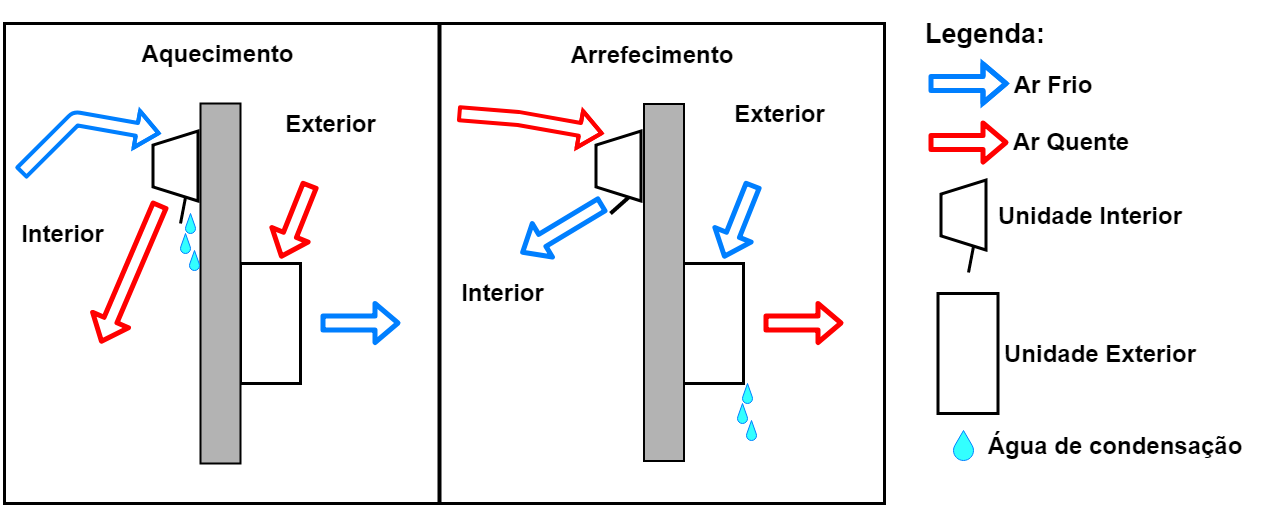
Figure 1 – Operation of an air conditioner.
TYPES OF EQUIPMENT
There are 3 types of solutions, according to the different needs and intended objectives.
A
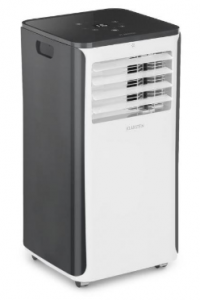
B
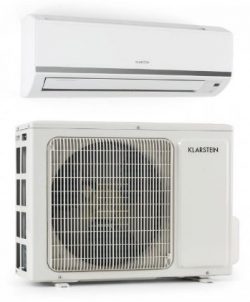
C
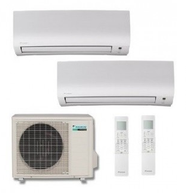
Figure 2 – Types of air conditioning: (A) Portable, (B) Monosplit and (C) Multisplit.
A. Portable – A single unit with all components and a tube connected to the outside (Figure 2A).
Advantages: Easy to move and does not require installation.
Drawbacks: It is necessary to have a window or an opening close to the appliance for placing the connection pipe to the outside.
B. Monosplit – With an outdoor unit and an indoor unit, it is the most common model (Figure 2B).
Advantages: More efficient than portable systems, it is easier to install.
Drawbacks: Only allows installation in a single room of the house.
C. Multisplit – Similar to Monosplit, but with an outdoor unit with the possibility of being connected to several indoor units (Figure 2C).
Advantages: It allows to cover different rooms of the house, the individual control of the set-points of ambient temperature and to use different configurations and capacities of indoor units.
Drawbacks: It does not allow simultaneous heating and cooling cycles, that is, if set for cooling, all equipment will have the same type of operation.
Energy Label
There are different labels according to the type of equipment and associated features: reversible (type A), only heating (type B) or just cooling (type C), as shown in the figure below.

Type A energy label (Reversible equipment label):
- Supplier name or trademark
- Supplier model
- Cooling function
- Heating function
- Energy efficiency class
- Cooling / heating load
- Seasonal energy efficiency for cooling
- Seasonal energy efficiency for heating
- Noise emission inside and outside the dwelling (in dB)
The energy label for air conditioning equipment applies to electrical equipment with a nominal capacity of 12kW or less, for cooling or heating (in cases where the product has no cooling function).
Case Study
Assuming an average electricity price of 0.1557 € / kWh [2], we will compare the costs of using air conditioning (energy class A +) with those of a 2000 W electric radiator (Joule effect, efficiency of 1).
Considering a house with the typology T2, with a radiator for each room that only works in the winter period, for a total of 386 hours of heating (2 hours a day during the week and 4 hours a day at weekends) .
For air conditioning equipment, one unit per division is also considered, and its operation has a total of 552 cooling hours (the same number of winter hours as radiators, additionally operating in the summer period, with the same number of hours / day for weekdays and weekends).
For this comparison, radiators with a power of 2000 W and equivalent air conditioning units were considered:
BEFORE
Living room (25 m2)
Radiator of 2000 W
Bedroom1 (15 m2)
Radiator of 2000 W
Bedroom2 (12 m2)
Radiator of 2000 W
AFTER
Living room (25 m2)
Air conditioning of 3000 W
Bedroom 1 (15 m2)
Air conditioning of 2000 W
Bedroom 2 (12 m2)
Air conditioning of 2000 W
Consumption is obtained by multiplying the power of the equipment by the number of hours they are in operation, from where we obtain:
RADIATOR COST
Living room (25 m2)
120,20 €
Bedroom1 (15 m2)
120,20 €
Bedroom 2 (12 m2)
120,20 €
AC Cost
Living room (25 m2)
91,12 €
Bedroom 1 (15 m2)
60,75 €
Bedroom 2 (12 m2)
60,75 €
According to the tables above, using an air conditioning system over the course of a year, it appears that the costs of use are lower than those of radiators that work only in the winter period. This situation is due to the fact that the air conditioning systems use the outside air for heat exchange and use a refrigerant, providing them with very high efficiencies. As mentioned, air conditioning will contribute to the healthiness of your home, since it allows you to filter and / or dehumidify the indoor air. In this case study, the use of air conditioning in relation to a radiator allows an annual saving of around € 148 (in which the costs of installing the systems were not considered).
Savings Tips
- Before purchasing air conditioning equipment, you should seek advice from a qualified HVAC professional in order to provide you with information about the type of equipment and the power that best suits your needs.
- Periodic preventive maintenance ensures the correct functioning of the air conditioning. This should check the state of the filters of the indoor units, alarms and system errors, leak detection and correction and verification of the refrigerant circulation circuit, as well as all the mechanical components of the equipment.
- For moderate use, it is recommended to have this equipment adjusted to a temperature suitable for outdoor conditions: 18 ° C in winter and 25 ° C in summer (reference value indicated in the legislation on energy certification of buildings, SCE).
- Install awnings, close blinds and draw curtains to keep the temperature at home and reduce the need for air conditioning.
- It is important to place air conditioning units in places that are not affected by the sun or where there is good air circulation.
- The installation of Efficient windows allows to reduce heat losses, which represent 30% of the heating needs.
- Consider installing thermal insulation on walls and roofs in order to reduce heating needs.
[1] Energy Consumption Survey in the Domestic Sector 2010, Directorate General for Energy and Geology (DGEG) and INE (National Statistics Institute); [2] Regulated tariff 2019 defined by the Energy Services Regulatory Entity (ERSE); [3] Energy Label Manual, February 2017; [4] The AC unit in this case has a higher rated power (3 kW) since these units are designed for the worst case, cooling.

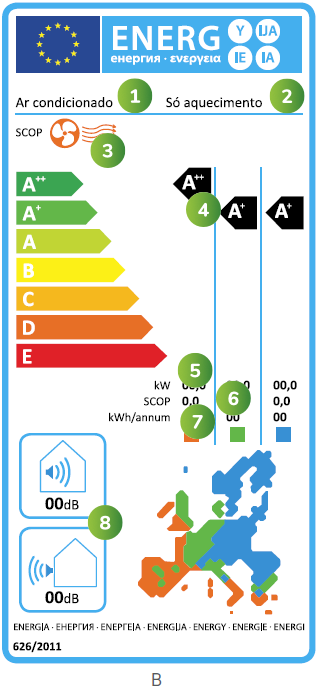
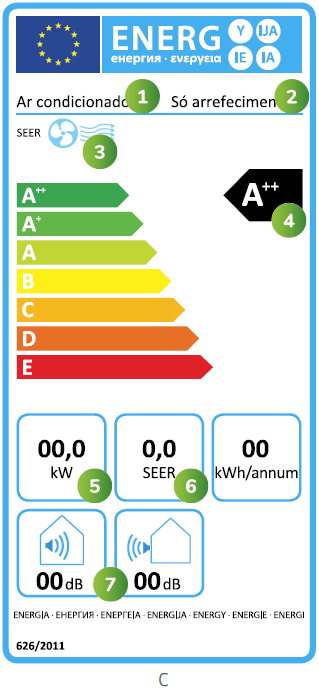


 Simulador Simples
Simulador Simples Simulador Avançado
Simulador Avançado